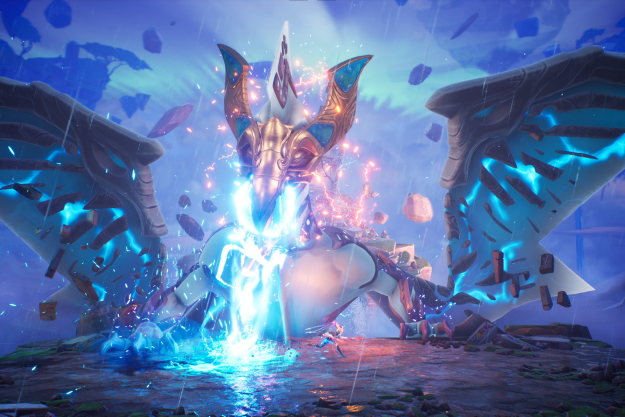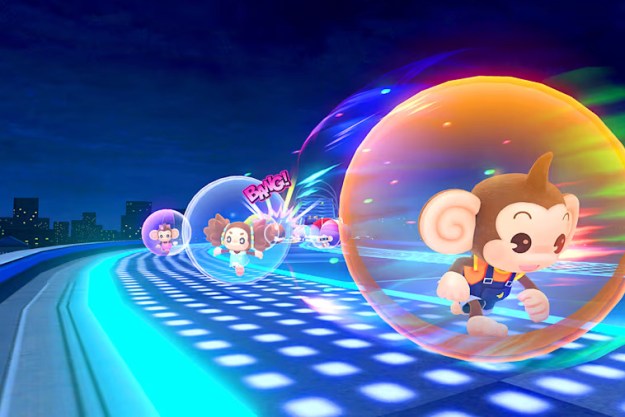When you meet another player in Absolver, you’ll have a choice: beat down, or team up.
As an action-adventure game with an emphasis on hand-to-hand duels, Absolver’s primary emphasis is on the beat-down part. You’re a warrior with martial arts capabilities that make you a badass, especially if you’re able to chain together multiple moves to deliver crushing blows to your enemies within the game’s strategic, thoughtful combat system. And as you move through its world, occasionally your game will mix with those of other players, allowing you to meet. And fight.
But Absolver isn’t just about pummeling your enemies (or other players) into submission. It can also be about cooperation.
In fact, as Creative Lead Pierre Tarno explained at this month’s PlayStation Experience, you might want to take a breather when you run across another player — and consider becoming their teacher instead of their executioner.
Absolver isn’t just about pummeling your enemies into submission. It can also be about cooperation.
“We want there to be incentives for cooperating,” Tarno said. “It’s in your interest to have a mentor and to have students.”
Absolver’s fighting system doles out moves the way action RPGs like Destiny and Diablo do loot: You learn them after getting beat by them, and unlock them over time through winning fights and earning experience points. But with the game’s mentor-student system, one player can also teach their moves to another. Teaming up with players in the world will carry some advantages, Tarno said, and the mentoring system will be one of them — there will be an upshot to being both a student and a teacher.
Tarno didn’t say exactly what those incentives will be — from the sounds of things, developer Sloclap is still thinking through its options — but cooperative teams are going to be a big part of the experience. You’ll be able to gang up to into groups of three as you work through Absolver’s world, so meeting others while playing and becoming buds will be as much a part of the game as jumping into Absolver with your existing friends.
Going it alone
Of course, while Absolver’s multiplayer offers a lot of interesting caveats to the experience, at its core, the game is about wailing on each other. Its methodical martial arts combat comes from the real world (several of Sloclap’s team members practice martial arts, Tarno said) and carries a ton of depth, allowing players to define their various move sets and combat stances for a free-flowing, strategic kind of pummeling.
Absolver’s big hook is the seamless integration of multiplayer into its tightly focused, hand-to-hand combat duels, but playing with other people isn’t the only way to enjoy the game. You’ll face off against, trade with, or mentor other players as you go, but Absolver also has a narrative for players to work through and characters to meet along the way that doesn’t demand that you cooperate with other players.
The frame of Absolver is the narrative of exploring the ruined capital city of an old fallen empire, in an attempt to work toward becoming an “Absolver,” a Jedi-esque order of fighters who work to maintain order in the world.
“Narratively, you’re trying to figure out why you’re here, who put you here, and what the rules of the place are, both human and magical,” Tarno said. “Your objective is to become an Absolver, but eventually you might come to question the morality of becoming one. You don’t really know what that means, and you’ll kind of find out as you explore.”
To bash or not to bash?
Adding seamless multiplayer to the mix means that a central part of the Absolver experience is not knowing if the person you happen across in the middle of the game is friend or foe. Like online multiplayer survival games such as Day Z, part of the experience is those fraught moments when you meet another person and neither of you knows the other’s intentions.
“A new story unfolds every time you meet someone,” Tarno said. “It’s kind of a social experiment.”
“A new story unfolds every time you meet someone. It’s kind of a social experiment.”
Right now, Tarno said communication between players will be limited: You won’t be able to talk to each other. Instead, you can use emoji to heighten (or cut) the tension in those uncertain moments when two players meet. You can make your opponent aware that you’re here to crack skulls, but you can also ask for cooperation, or offer to trade items.
And of course, betrayal is always a possibility.
That’s where Absolver sounds like it will get very interesting. The focus of the game is on fighting other players, and when you feel like bashing folks with no waiting, you’ll be able to access in-game “altars” that can transport you straight into a dedicated player-vs.-player matchmaking system. But out in the world, the organic nature of what happens when you meet other people is what Absolver is all about, Tarno said.
“The game really focuses on the online community,” he said.

Maintaining that community will be Sloclap’s focus after Absolver’s release, too. The first major update to the game post-launch will introduce procedurally generated dungeons where players can face off against computer-controlled enemies, as opposed to other players, Tarno said, making them good places to band together and create teams.
There will be more post-launch content coming as Sloclap works to continue to support Absolver, Tarno said. Right now, there are plans in place for additional content like procedurally generated dungeons, as well as more equipment and different kinds of weapons.
Sloclap will also be looking to add more fighting styles over time, tapping into new ways to demolish your enemies — or to teach them to your future proteges. What players do with their capabilities and knowledge in Absolver when it’s released sometime in 2017 will be up to them.






